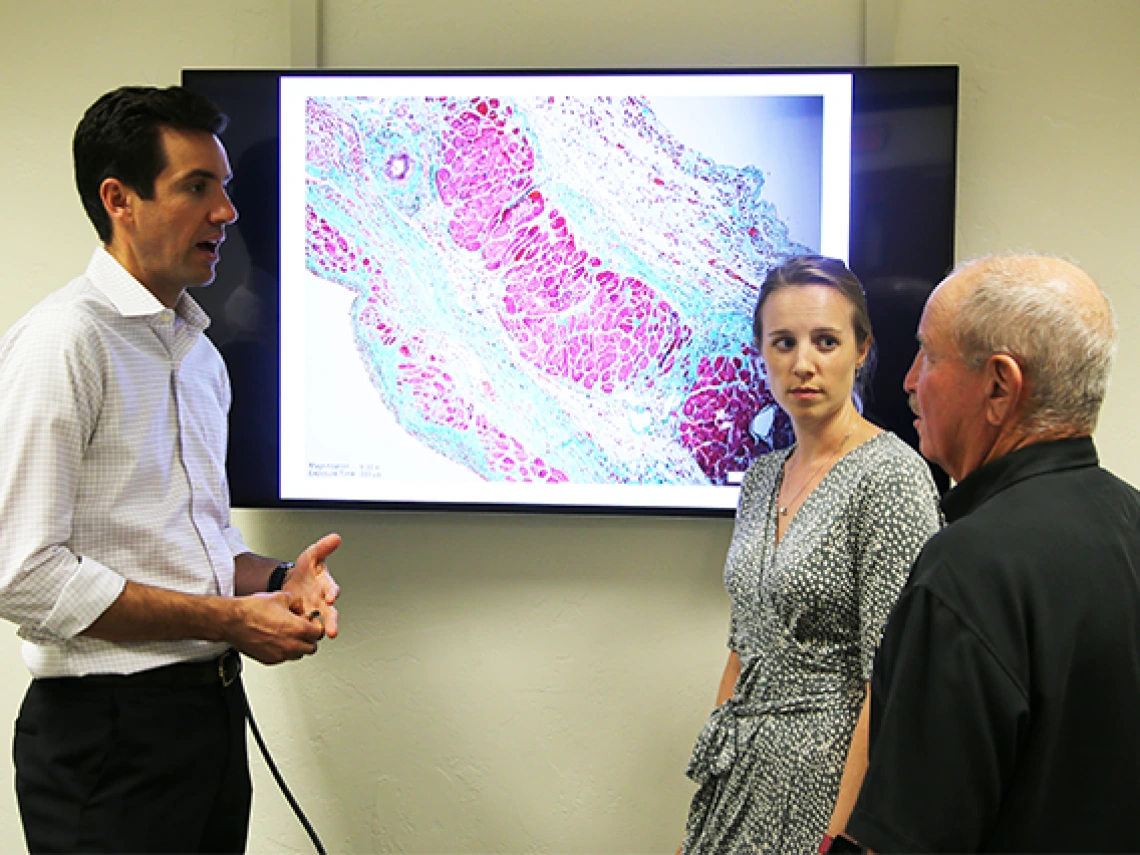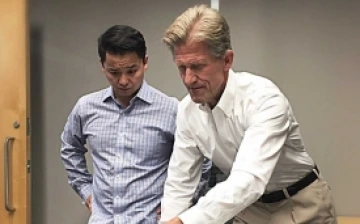What do you do with an early-stage invention? Move it forward with Asset Development funding.
$1.5M available to help UArizona innovators advance inventions to impact

Left to right: Jordan Lancaster, Jen Koevary, and Steven Goldman of the University of Arizona and startup Avery Therapeutics.
Paul Tumarkin/Tech Launch Arizona
In the 10 years of its existence, Tech Launch Arizona (TLA) – the office of the University of Arizona that creates impact by commercializing inventions arising from research and innovation – has worked with hundreds of inventors and over 2,500 inventions.
“If a member of our community has a great invention, we want to help develop and get it out into the world where it can create impact,” says Doug Hockstad, associate vice president of TLA. “And we have funding available to help make it happen.”
TLA’s commercialization efforts have advanced university inventions for the last ten years, creating impact in our community and worldwide, launching over 130 startups, and licensing over 500 inventions to startups and existing companies bringing them to market. All this work resulted in $1.6 billion in economic output.
TLA has a number of resources it brings to bear to move great innovations forward, such as market research, intellectual property protection, startup support, and mentoring for inventors and startup teams.
But one of the most valuable, and sometimes underutilized, resources is TLA’s Asset Development funding.
“Since most inventions are so early stage,” Hockstad says, “they’re often not ready to be licensed. They’re not ready for a company or startup to take them forward yet, so they need an infusion of funds to take the next step and to remove some of the risk associated with commercializing new technologies.”
$1.5M in Available Funds for Researchers and Students
To address this need, TLA has an Asset Development Program which provides funding for projects designed to answer key questions about inventions and prepare them for a company to adopt them into their product pipeline.
Such questions may be: Is there a prototype so a company can see it in action? Is there a feasibility study that proves it can be done? Can the invention be produced and function at scale?
Asset Development funding can be applied to answer these questions and many more, but the goal is always to further validate or advance the innovation to reduce risk and make it attractive for the marketplace.

Left to right: Jeffrey Pyun and Robert Norwood.
University Communications
Projects range across the fields of academia, from life sciences to physical sciences to software and copyright. Jeffrey Pyun, professor in the Department of Chemistry and Biochemistry, and Robert Norwood, professor at the James C. Wyant College of Optical Sciences, recently completed a proof-of-concept (POC) project using AD funding. With the support, they were able to develop a new magneto-optical material composed of polymers and magnetic nanoparticle units that afforded remarkable optical properties.
“The results from our short 6-month POC project enabled engagement with major tech companies like Microsoft and Apple, and DOD agencies like the Air Force Research Laboratory on possible applications of these materials for low energy consumption optical devices,” said Pyun. “The work also opened up the opportunity for us to submit a proposal for external funding and two high-profile publications.”
Steven Goldman, MD, professor at the College of Medicine-Tucson and the Sarver Heart Center, also benefited from the program; it allowed his team to advance a cardiac patch to repair damaged heart muscle by giving them the resources needed to further examine the patch’s mechanisms of action.
“The funding gave us the resources to define changes in gene expression at site of injury (myocardial infarction) and repair with our cardiac patch,” he said. “This work provided the data we needed to license the enhanced technology to our startup, Avery Therapeutics.”
In addition to reducing the risk associated with licensing an early-stage invention and providing data needed to file a provisional patent application, the results of the AD work also allowed the team to submit a new grant application to the National Heart, Lung, and Blood Institute, part of the National Institutes of Health, in October 2022.
Funded partially by TRIF or the Technology and Research Initiative Fund and through a share of the royalties produced through licensing, the TLA Asset Development (“AD”) program has had a budget of $1 million a year, but TLA recently increased it to $1.5 million with the goal of supporting more, and larger, projects.
“The university is highly committed to helping inventors pursue these commercial pathways for creating impact from UA innovation,” said Elizabeth “Betsy” Cantwell, senior vice president for research and innovation. “That’s why we dedicate these funds and fully support our faculty and research community pursuing this kind of work.”
AD project grant amounts vary and can be as small as just a few thousand dollars and range upward to $50,000 or more. Funding decisions are made expeditiously, and funds can be made available within weeks of acceptance of the application, which makes them a very useful tool for UA researchers.
“The inventors we work with are employees that hail from every part of the university,” Hockstad says. “From faculty to staff to graduate students, we serve every employee who has a great idea to bring to the world.”
To date, over 130 Asset Development projects have been completed. Projects TLA has funded include the development of blood tests to detect cancer developed in the College of Medicine – Tucson, a new tunable laser developed in the College of Optical Sciences, geopolymer bricks made from mine tailings developed in the College of Engineering, and software for insider threat detection developed in the Eller College of Management MIS program. Over 30% of the funded and completed projects have been licensed, with approximately another 20% ready to be licensed.
Applying for AD Funds
To apply for AD funding, applicants start by having a conversation with one of TLA’s expert licensing managers; applicants are matched with a licensing manager who is dedicated to their college or attuned to their field, such as health and medicine, engineering, optics, software, or copyright. Working with that licensing manager – who also has expertise in industry, licensing, and intellectual property – applicants collaborate to formulate an Asset Development proposal.
To be considered for AD funding, applicants must first demonstrate that they fulfill 4 requirements: 1) Their invention must be disclosed to TLA; 2) The invention must not yet be licensed; 3) The primary inventor is a UArizona employee; and 4) if the technology is jointly owned by the UA and another institution, the UA is the designated lead.
Funding is available throughout the year and there is no specific proposal deadline. Proposals are reviewed by TLA team members as well as Commercialization Partners – a team of outside industry experts and experienced entrepreneurs who provide feedback on each proposal.
For more information about submitting an Asset Development proposal, contact Paul Tumarkin, assistant director of marketing and communications, at pault@tla.arizona.edu.

